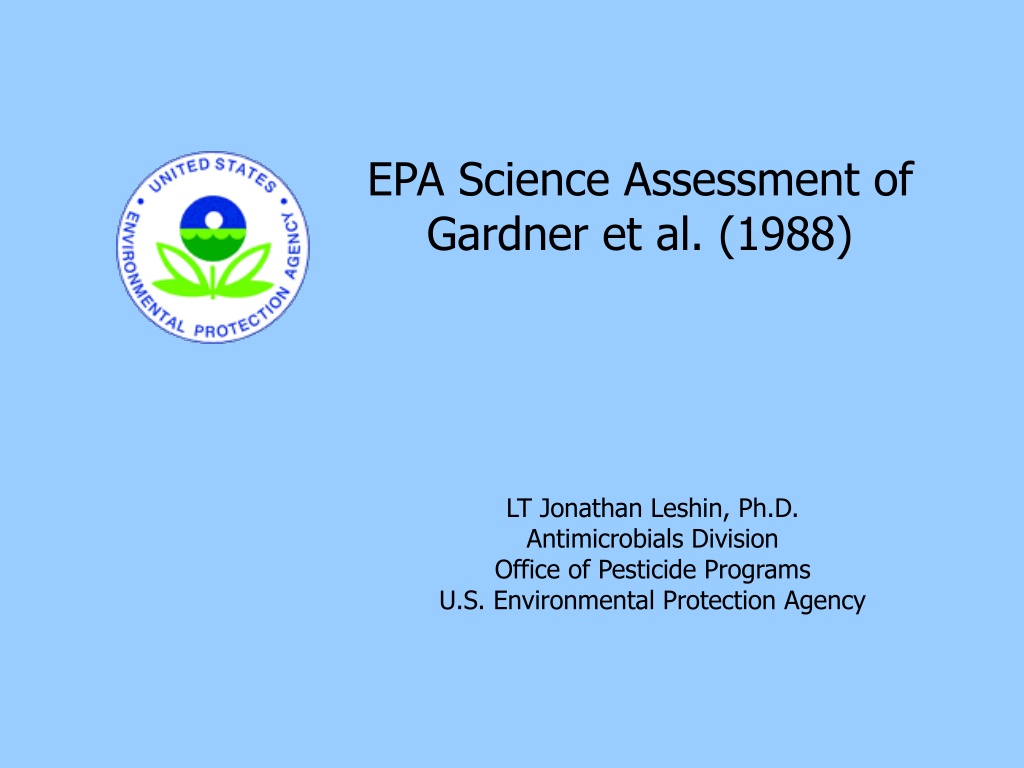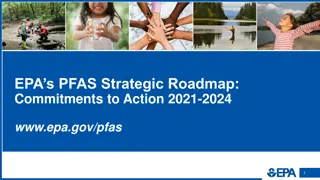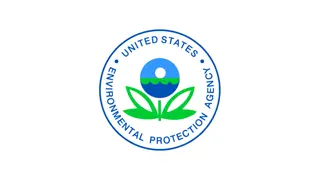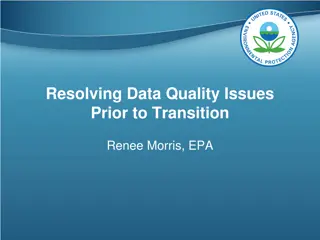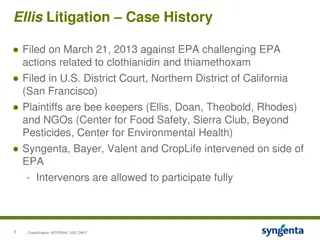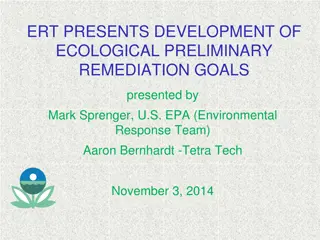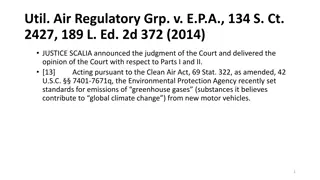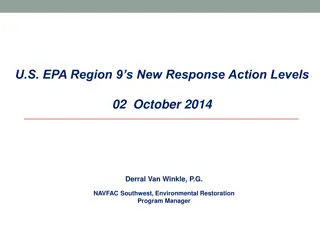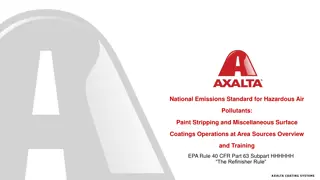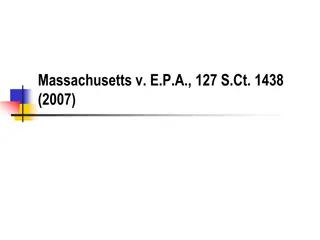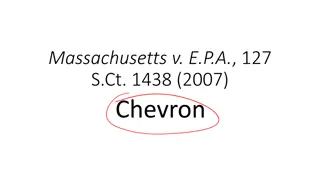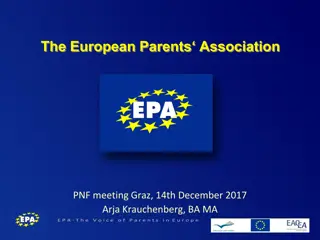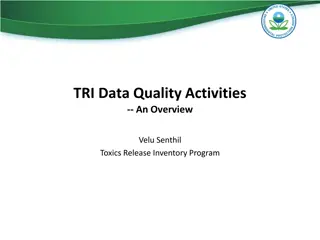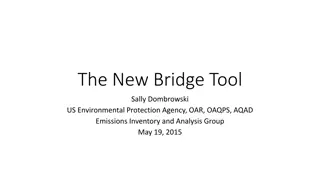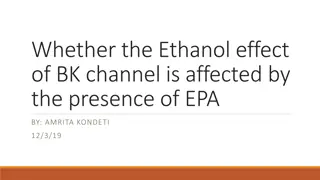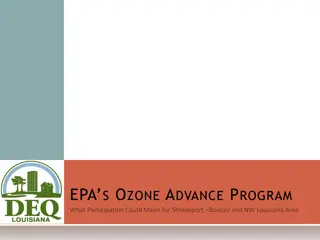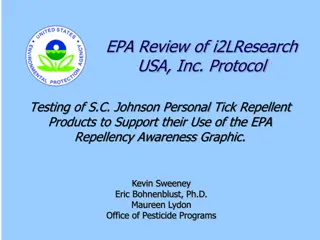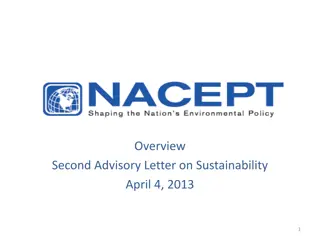EPA Science Assessment of Gardner et al. 1988 Study
The EPA conducted a study to determine the tolerable upper limit for iodine consumption among males aged 22-40 without thyroid issues. The study involved administering sodium iodide at different doses over 14 days and measuring various thyroid hormone levels before and after. The findings shed light on the effects of iodine on thyroid function.
Download Presentation

Please find below an Image/Link to download the presentation.
The content on the website is provided AS IS for your information and personal use only. It may not be sold, licensed, or shared on other websites without obtaining consent from the author. Download presentation by click this link. If you encounter any issues during the download, it is possible that the publisher has removed the file from their server.
E N D
Presentation Transcript
EPA Science Assessment of Gardner et al. (1988) LT Jonathan Leshin, Ph.D. Antimicrobials Division Office of Pesticide Programs U.S. Environmental Protection Agency 1 1
Study Information Conducted at the Department of Medicine, Medical College, Richmond VA Study Objective Determine a tolerable upper limit for iodine consumption Subjects 30 Males, euthyroid, no history of thyroid disease or use of medications known to affect thyroid function or previous reactions to iodine, age 22-40 Self control study 2
Test Substance Sodium Iodide dissolved in water (500, 1500 or 4500 g/ml per day), co-administered with 1 mg/ml of ascorbic acid. Administered as two 0.5 ml solutions twice daily Study lasted 14 days The subjects were randomly sorted into groups dosed with either 500, 1500 or 4500 g/ml Subjects maintained their normal diets Some diets may be higher in iodine than others but assumed average was 300 g/day 3
Study Method All subjects had initial evaluations for the study After an eight hour fast, baseline levels of T4, T3, T3-charcoal uptake, and thyroid stimulating hormone (TSH) were measured Stimulated TSH was measured after stimulation by thyrotropin releasing hormone (TRH) every 15 minutes for an hour On day 15, the protocol was repeated 4
Endpoints Serum T4 Serum T3 T3-charcoal uptake TSH Stimulated TSH 5
Results - 1 Table 1: Serum thyroid hormone concentrations before and after iodide administration Iodide dose Serum T4 ( g/dl) T3 charcoal uptake ratio 500 g/ml (n= 10) 1.06 0.04 1.09 0.04 NS 1500 g/ml (n= 10) 1.02 0.04 1.00 0.05 NS 4500 g/ml (n= 10) 1.12 0.09 1.11 0.04 NS Serum T3 (ng/dl) FTI Paired Student s t-test p value Mean SEM NS = Not significant Day 15 compared with Day 1 9.2 0.5 9.2 0.4 NS 9.8 0.8 10.0 0.6 NS 153 8 158 7 NS Day 1 Day 15 p-value 8.6 0.4 7.5 0.9* 0.005 8.7 0.5 7.5 0.4* 0.005 162 11 161 7 NS Day 1 Day 15 p-value 8.9 0.6 8.2 0.7* 0.02 9.9 0.6 9.0 0.6* 0.005 151 9 155 6 NS Day 1 Day 15 p-value 6
Results - 2 Table 2: Effect of iodide on basal and TRH stimulated serum TSH concentration TSH ( U/ml) min after TRH 15 30 500 g/day (n= 10) Maximum TSH increment Iodide dose Paired Student s t-test p value Mean SEM. NS = Not significant Day 15 compared with Day 1. 0 45 60 3.0 0.3 9.7 1.4 12.0 1.8 11.0 1.7 9.7 1.8 9.0 1.6 Day 1 3.3 0.5 11.1 1.5 15.2 4.8 13.7 2.3 12.8 2.3 12.5 2.2 Day 15 p-value NS 0.05 0.02 0.02 0.002 0.03 1500 g/day (n= 10) 2.5 0.3 9.6 1.5 11.6 1.8 10.7 1.7 8.7 1.5 9.4 1.7 Day 1 3.7 0.5 14.2 2.2 16.3 2.2 14.6 1.9 12.5 1.9 12.8 2.0 Day 15 p-value 0.04 0.004 0.002 0.01 0.002 0.005 4500 g/day (n= 10) 8.8 1.1 9.5 1.1 2.1 0.4 8.9 1.0 7.8 0.9 7.5 1.0 Day 1 3.7 0.6 12.7 1.8 15.5 2.0 14.0 1.4 12.0 1.6 12.2 1.6 Day 15 p-value 0.008 0.003 0.001 0.001 0.001 0.001 7
Conclusions At 1500 and 4500 g/day there were decreases in serum and free T4 No change in T3 charcoal uptake or serum T3 At 500,1500 and 4500 g/day there were increases in both basal and TRH induced TSH 8
EPA Ethics Assessment of Gardner et al. (1988) Kelly Sherman Office of Pesticide Programs U.S. Environmental Protection Agency 9 9
Introduction Research was conducted in the 1980s, before promulgation of the 2006 Human Studies Rule Considered an intentional exposure human toxicity study because it evaluated potential the toxic effects of iodine intake on thyroid function 40 CFR 26.1602 requires HSRB review for pre-rule intentional exposure toxicity studies upon which EPA intended to rely Study was located by EPA, not submitted to the Agency, so 40 CFR 26.1303 does not apply 10 10
Value to Society Provides data about whether small increases in iodine intake affect thyroid function The research was important because at the time of the study, dietary changes were resulting in increased iodine intake The data are potentially useful in EPA s human health risk assessments for products containing iodine 11 11
Subject Selection 30 male subjects, ages 22-40 The subjects were medical students or employees of the Medical College of Virginia, or people whose names appeared on a list of interested research candidates maintained by the research center Inclusion/exclusion criteria: Subjects had to be healthy, euthyroid, not on any medications that affect thyroid function, no history of thyroid disease 12 12
Risks, Risk Minimization, Benefits & Risk:Benefit Balance Article is silent Benefits No benefits to subjects; Societal benefit from knowledge about iodine intake Risk:Benefit Balance Not discussed in article Risks were minimal, so the potential benefits to society outweigh the risks 13 13
Ethics Oversight Research was reviewed and approved by the Virginia Commonwealth University Committee on the Conduct of Human Research 14 14
Informed Consent Article states that each subject provided written informed consent Dr. Gardner stated: Subjects were given the opportunity to read the protocol and ask questions Investigators confirmed subject s understanding Copy of the consent form not available 15
Respect for Subjects Dr. Gardner stated that subjects were paid approximately $150-200 to participate Subjects privacy protected We do not know whether subjects were free to withdraw during the study 16
Standards for Documentation The requirement at 40 CFR 26.1303 to document the ethical conduct of research submitted to EPA does not apply: Study was obtained from the public literature, not submitted to EPA EPA located the study at its own initiative 17 17
Standards of Conduct Conducted prior to 1988, before EPA s Rule at 40 CFR part 26 took effect FIFRA 12(a)(2)(P) does not apply Did not involve use of a pesticide Declaration of Helsinki (1983) Research must be scientifically sound Clear purpose and protocol, reviewed and approved by an independent ethics committee Prior informed consent 18
Standards for EPA Reliance 40 CFR 26.1703 Prohibits EPA reliance on data involving intentional exposure of pregnant or nursing women or of children 40 CFR 26.1704 Prohibits EPA reliance on data if there is clear and convincing evidence that: (1) Conduct of the research was fundamentally unethical; or (2) Conduct of research was deficient relative to the ethical standards prevailing at the time the research was conducted in a way that placed participants at increased risk of harm or impaired their informed consent. 19
Compliance with Standards for EPA Reliance 40 CFR 26.1703 The subjects were all males above the age of 18 40 CFR 26.1704 No clear and convincing evidence that the conduct of the research was fundamentally unethical No clear and convincing evidence that the conduct of the research was deficient relative to prevailing ethical standards 20 20
Conclusion If it is deemed scientifically valid and relevant, there are no barriers in FIFRA or in 40 CFR 26.1703 or 26.1704 to EPA s reliance on the Gardner et al. (1988) study in actions taken under FIFRA or 408 of FFDCA 21 21
Charge Questions 1. Is the Gardner et al. (1988) study scientifically sound, providing reliable data? 2. If so, is this study relevant for quantitative use in support of an assessment of the oral risk of exposure to iodine? 3. Does the study meet the applicable requirements of 40 CFR part 26 subpart Q? 22
